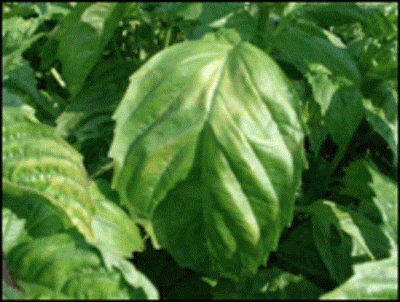Basil downy mildew is caused by the fungus-like oomycete pathogen Peronospora belbahrii. This disease was first confirmed in the United States in Florida in 2007 and by 2008 it was widespread in the northeast and has been present each season since. The pathogen does not overwinter in Connecticut. It is seed-borne and spreads by wind-borne spores (sporangia) that move north during the summer, favoring high humidity and temperatures in the upper 60s F. Infection renders the basil unsuitable for fresh market sale although the leaves are safe for human consumption. Hosts of the basil downy mildew pathogen include both culinary and ornamental basil varieties.
Symptoms
Symptoms begin by the end of July as yellowing that is restricted by the veins on the upper surface of the leaf. Early symptoms can resemble nutrient deficiency. Symptoms on seedlings are yellowing and leaf cupping. During wet or humid weather, sporulation will be visible on the undersides of the leaves associated with the yellow areas. The sporulation is purplish-brown to grayish and has a fuzzy or dirty appearance. These sporangia are wind-blown and rain splashed to new infection sites. See images of symptoms and sporulation in the photos below. Affected leaves will brown and fall off and a plant can be defoliated in just a few days.

(photo by J. Allen, UConn).

(photo by Dr. M. T. McGrath, Cornell University).
Cultural Control
- Promote good air circulation by using generous plant spacing and orienting the rows parallel to the prevailing wind direction.
- Avoid overhead irrigation or water early in the morning to promote leaf dryness.
- Plant in full sun.
- Use clean, steam-treated seed. Do not use seed from infected plants.
- Grow less susceptible varieties.
- Spores are produced at night so check under leaves in the early morning.
- Remove, bag, and trash any leaves that are showing symptoms. Do not compost them.
- If basil downy mildew is detected remove any leaves that are not affected and use them immediately or make pesto.
- Rotate planting sites each year.
Chemical Control
- Neem oil, copper-based fungicides, and potassium bicarbonate are all preventive controls that can be used in a home garden although the level of control is not high. Both sides of leaves should be sprayed on a weekly basis early in the morning or in the evening. Never spray plants in the heat of the day. Nothing will cure a plant of basil downy mildew.
Less Susceptible Varieties
The sweet basil varieties (Ocimum basilicum) are generally more susceptible than O. citriodorum and O. americanum. The red leaf types ‘Red Leaf’, ‘Red Rubin’, Thai basil ‘Queenette’, lemon and lime basils ‘Lemon’, ‘Lemon Mrs. Burns’, ‘Sweet Dani Lemon basil’, ‘Lime’ and spice varieties ‘Spice’, ‘Blue Spice’, and ‘Cinnamon’ are less susceptible to basil downy mildew.
Despite good cultural practices, pests and diseases at times may appear. Chemical control should be used only after all other methods have failed. For pesticide information or other questions please call toll free: 877-486-6271.
UConn Home and Garden Education Center, 2019